Analysis of Enterprise Architecture Applications for Archifarm
VerifiedAdded on 2020/03/16
|9
|1500
|274
Report
AI Summary
This report analyzes the enterprise architecture of Archifarm, a dairy farm facing challenges related to production costs and disease management. The study focuses on the application of Precision Livestock Farming (PLF) technologies, data analysis programs, and organizational restructuring to improve efficiency and profitability. The information architecture maps the company's assets, goals, and organizational structure. The report examines application usage, cooperation, and data dissemination within Archifarm, including the integration of PLF sensors, data analysis, and potential restructuring of farm operations. The analysis includes diagrams illustrating application cooperation and data flow, providing insights into the relationships between different components and stakeholders within the business. References to relevant literature on enterprise architecture and business modeling are also included.
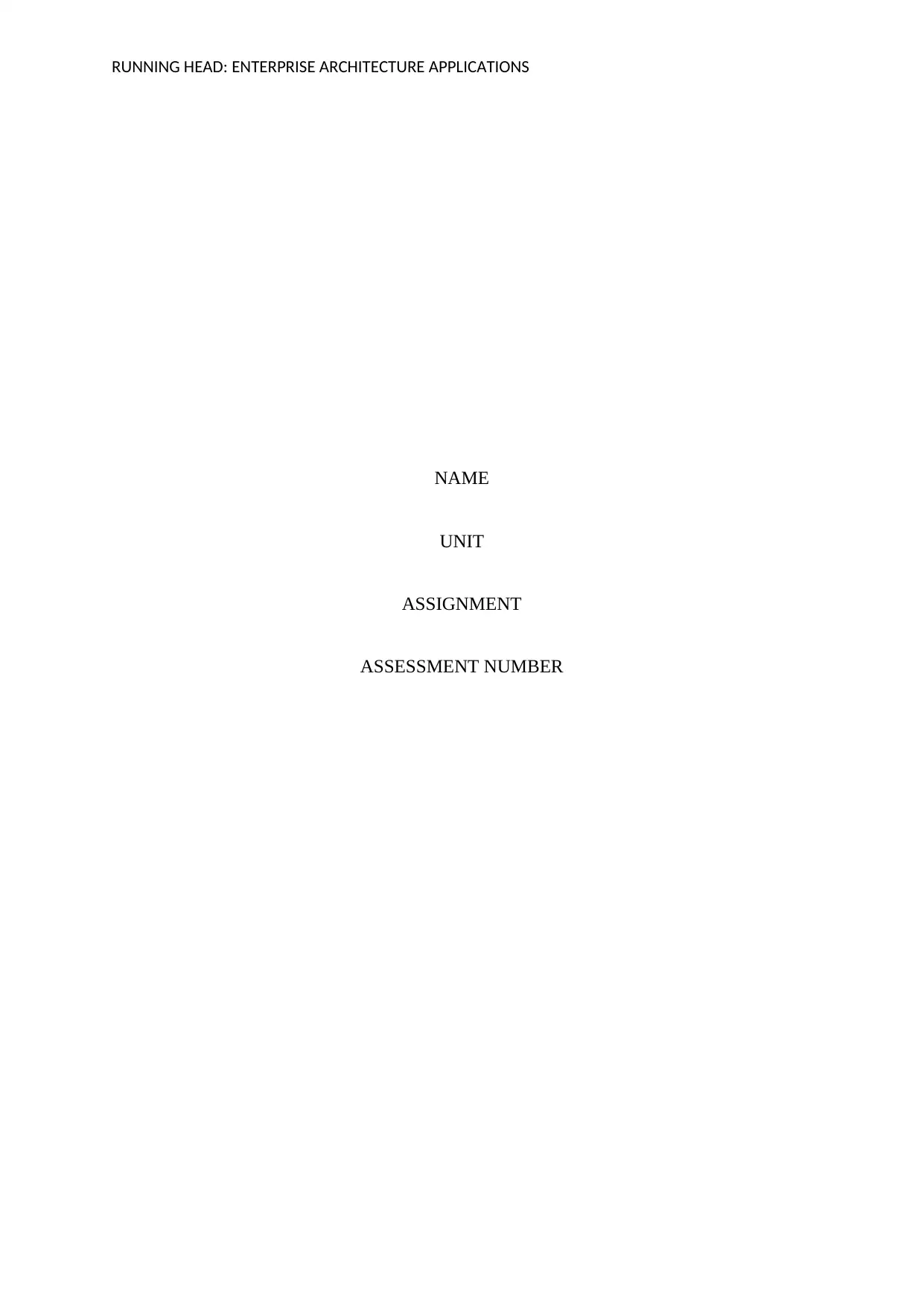
RUNNING HEAD: ENTERPRISE ARCHITECTURE APPLICATIONS
NAME
UNIT
ASSIGNMENT
ASSESSMENT NUMBER
NAME
UNIT
ASSIGNMENT
ASSESSMENT NUMBER
Paraphrase This Document
Need a fresh take? Get an instant paraphrase of this document with our AI Paraphraser
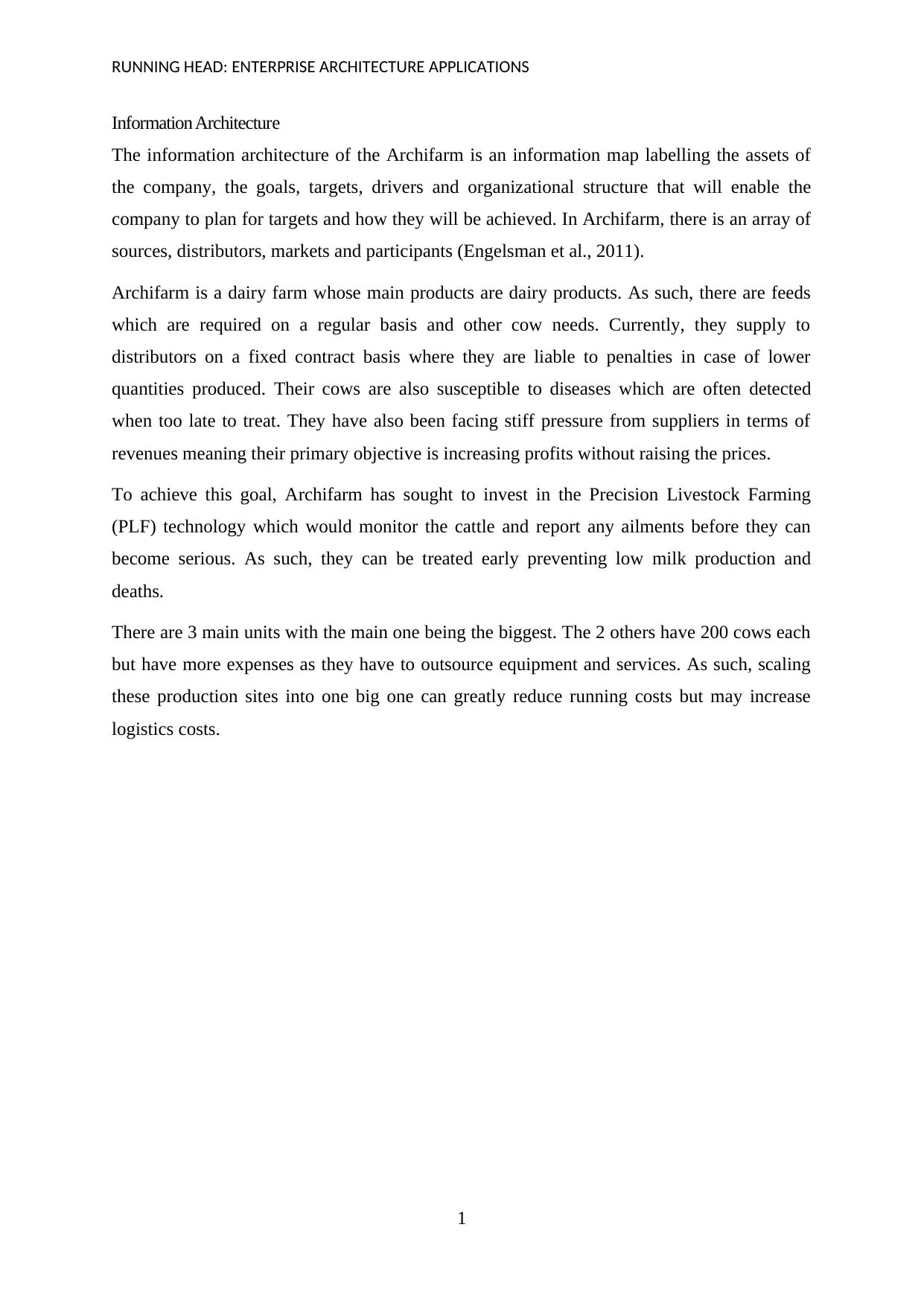
RUNNING HEAD: ENTERPRISE ARCHITECTURE APPLICATIONS
Information Architecture
The information architecture of the Archifarm is an information map labelling the assets of
the company, the goals, targets, drivers and organizational structure that will enable the
company to plan for targets and how they will be achieved. In Archifarm, there is an array of
sources, distributors, markets and participants (Engelsman et al., 2011).
Archifarm is a dairy farm whose main products are dairy products. As such, there are feeds
which are required on a regular basis and other cow needs. Currently, they supply to
distributors on a fixed contract basis where they are liable to penalties in case of lower
quantities produced. Their cows are also susceptible to diseases which are often detected
when too late to treat. They have also been facing stiff pressure from suppliers in terms of
revenues meaning their primary objective is increasing profits without raising the prices.
To achieve this goal, Archifarm has sought to invest in the Precision Livestock Farming
(PLF) technology which would monitor the cattle and report any ailments before they can
become serious. As such, they can be treated early preventing low milk production and
deaths.
There are 3 main units with the main one being the biggest. The 2 others have 200 cows each
but have more expenses as they have to outsource equipment and services. As such, scaling
these production sites into one big one can greatly reduce running costs but may increase
logistics costs.
1
Information Architecture
The information architecture of the Archifarm is an information map labelling the assets of
the company, the goals, targets, drivers and organizational structure that will enable the
company to plan for targets and how they will be achieved. In Archifarm, there is an array of
sources, distributors, markets and participants (Engelsman et al., 2011).
Archifarm is a dairy farm whose main products are dairy products. As such, there are feeds
which are required on a regular basis and other cow needs. Currently, they supply to
distributors on a fixed contract basis where they are liable to penalties in case of lower
quantities produced. Their cows are also susceptible to diseases which are often detected
when too late to treat. They have also been facing stiff pressure from suppliers in terms of
revenues meaning their primary objective is increasing profits without raising the prices.
To achieve this goal, Archifarm has sought to invest in the Precision Livestock Farming
(PLF) technology which would monitor the cattle and report any ailments before they can
become serious. As such, they can be treated early preventing low milk production and
deaths.
There are 3 main units with the main one being the biggest. The 2 others have 200 cows each
but have more expenses as they have to outsource equipment and services. As such, scaling
these production sites into one big one can greatly reduce running costs but may increase
logistics costs.
1
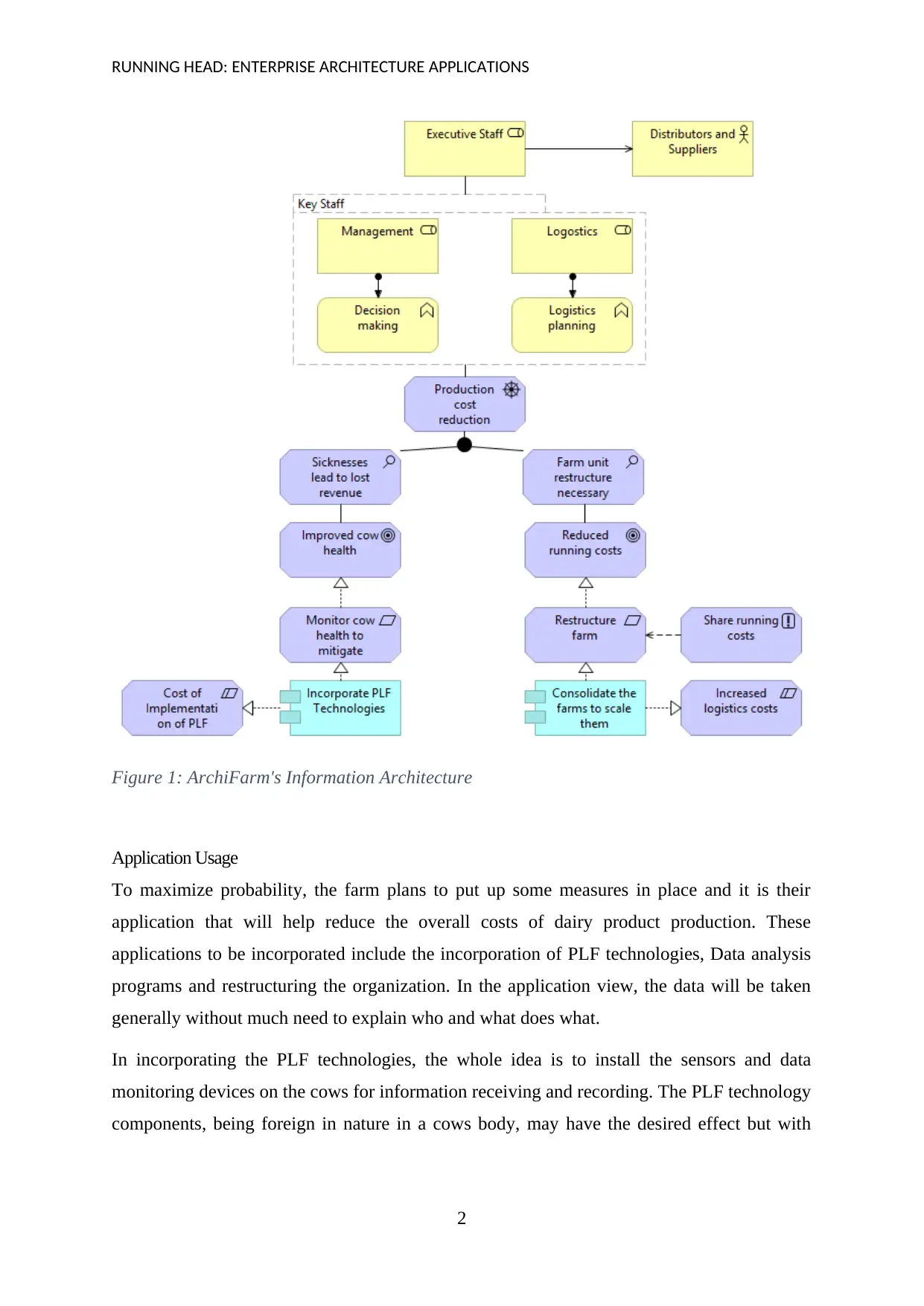
RUNNING HEAD: ENTERPRISE ARCHITECTURE APPLICATIONS
Figure 1: ArchiFarm's Information Architecture
Application Usage
To maximize probability, the farm plans to put up some measures in place and it is their
application that will help reduce the overall costs of dairy product production. These
applications to be incorporated include the incorporation of PLF technologies, Data analysis
programs and restructuring the organization. In the application view, the data will be taken
generally without much need to explain who and what does what.
In incorporating the PLF technologies, the whole idea is to install the sensors and data
monitoring devices on the cows for information receiving and recording. The PLF technology
components, being foreign in nature in a cows body, may have the desired effect but with
2
Figure 1: ArchiFarm's Information Architecture
Application Usage
To maximize probability, the farm plans to put up some measures in place and it is their
application that will help reduce the overall costs of dairy product production. These
applications to be incorporated include the incorporation of PLF technologies, Data analysis
programs and restructuring the organization. In the application view, the data will be taken
generally without much need to explain who and what does what.
In incorporating the PLF technologies, the whole idea is to install the sensors and data
monitoring devices on the cows for information receiving and recording. The PLF technology
components, being foreign in nature in a cows body, may have the desired effect but with
2
⊘ This is a preview!⊘
Do you want full access?
Subscribe today to unlock all pages.

Trusted by 1+ million students worldwide
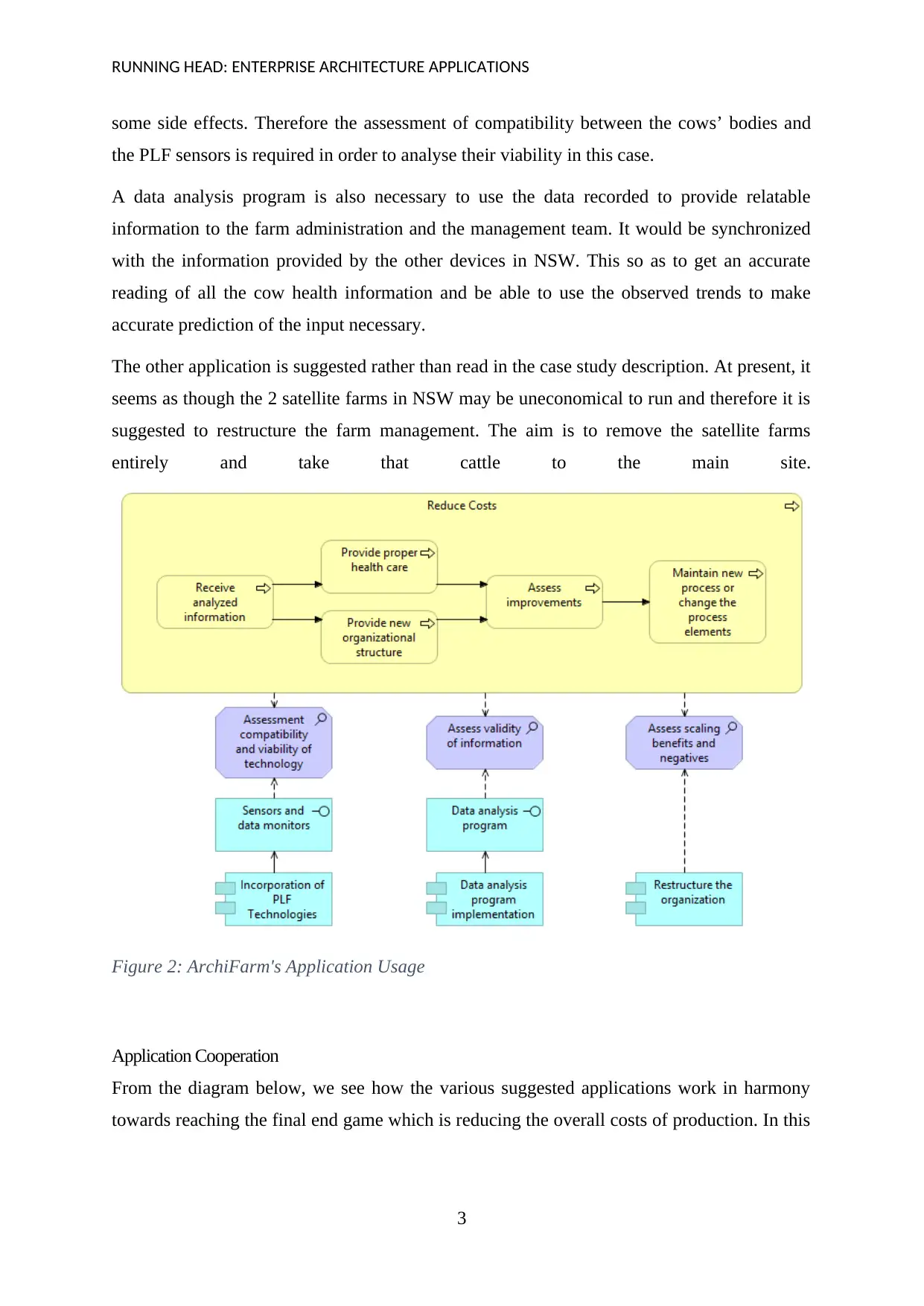
RUNNING HEAD: ENTERPRISE ARCHITECTURE APPLICATIONS
some side effects. Therefore the assessment of compatibility between the cows’ bodies and
the PLF sensors is required in order to analyse their viability in this case.
A data analysis program is also necessary to use the data recorded to provide relatable
information to the farm administration and the management team. It would be synchronized
with the information provided by the other devices in NSW. This so as to get an accurate
reading of all the cow health information and be able to use the observed trends to make
accurate prediction of the input necessary.
The other application is suggested rather than read in the case study description. At present, it
seems as though the 2 satellite farms in NSW may be uneconomical to run and therefore it is
suggested to restructure the farm management. The aim is to remove the satellite farms
entirely and take that cattle to the main site.
Figure 2: ArchiFarm's Application Usage
Application Cooperation
From the diagram below, we see how the various suggested applications work in harmony
towards reaching the final end game which is reducing the overall costs of production. In this
3
some side effects. Therefore the assessment of compatibility between the cows’ bodies and
the PLF sensors is required in order to analyse their viability in this case.
A data analysis program is also necessary to use the data recorded to provide relatable
information to the farm administration and the management team. It would be synchronized
with the information provided by the other devices in NSW. This so as to get an accurate
reading of all the cow health information and be able to use the observed trends to make
accurate prediction of the input necessary.
The other application is suggested rather than read in the case study description. At present, it
seems as though the 2 satellite farms in NSW may be uneconomical to run and therefore it is
suggested to restructure the farm management. The aim is to remove the satellite farms
entirely and take that cattle to the main site.
Figure 2: ArchiFarm's Application Usage
Application Cooperation
From the diagram below, we see how the various suggested applications work in harmony
towards reaching the final end game which is reducing the overall costs of production. In this
3
Paraphrase This Document
Need a fresh take? Get an instant paraphrase of this document with our AI Paraphraser
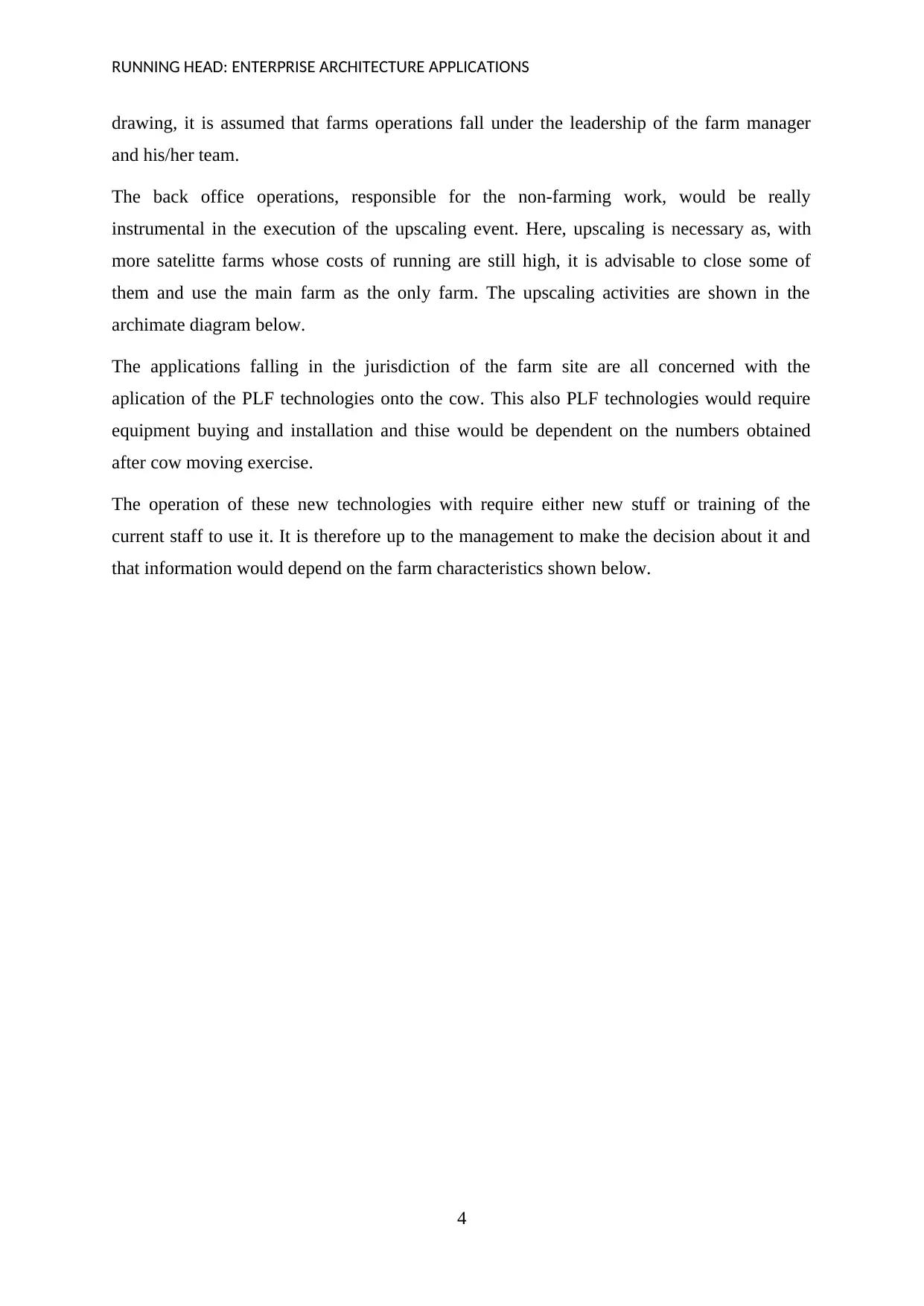
RUNNING HEAD: ENTERPRISE ARCHITECTURE APPLICATIONS
drawing, it is assumed that farms operations fall under the leadership of the farm manager
and his/her team.
The back office operations, responsible for the non-farming work, would be really
instrumental in the execution of the upscaling event. Here, upscaling is necessary as, with
more satelitte farms whose costs of running are still high, it is advisable to close some of
them and use the main farm as the only farm. The upscaling activities are shown in the
archimate diagram below.
The applications falling in the jurisdiction of the farm site are all concerned with the
aplication of the PLF technologies onto the cow. This also PLF technologies would require
equipment buying and installation and thise would be dependent on the numbers obtained
after cow moving exercise.
The operation of these new technologies with require either new stuff or training of the
current staff to use it. It is therefore up to the management to make the decision about it and
that information would depend on the farm characteristics shown below.
4
drawing, it is assumed that farms operations fall under the leadership of the farm manager
and his/her team.
The back office operations, responsible for the non-farming work, would be really
instrumental in the execution of the upscaling event. Here, upscaling is necessary as, with
more satelitte farms whose costs of running are still high, it is advisable to close some of
them and use the main farm as the only farm. The upscaling activities are shown in the
archimate diagram below.
The applications falling in the jurisdiction of the farm site are all concerned with the
aplication of the PLF technologies onto the cow. This also PLF technologies would require
equipment buying and installation and thise would be dependent on the numbers obtained
after cow moving exercise.
The operation of these new technologies with require either new stuff or training of the
current staff to use it. It is therefore up to the management to make the decision about it and
that information would depend on the farm characteristics shown below.
4
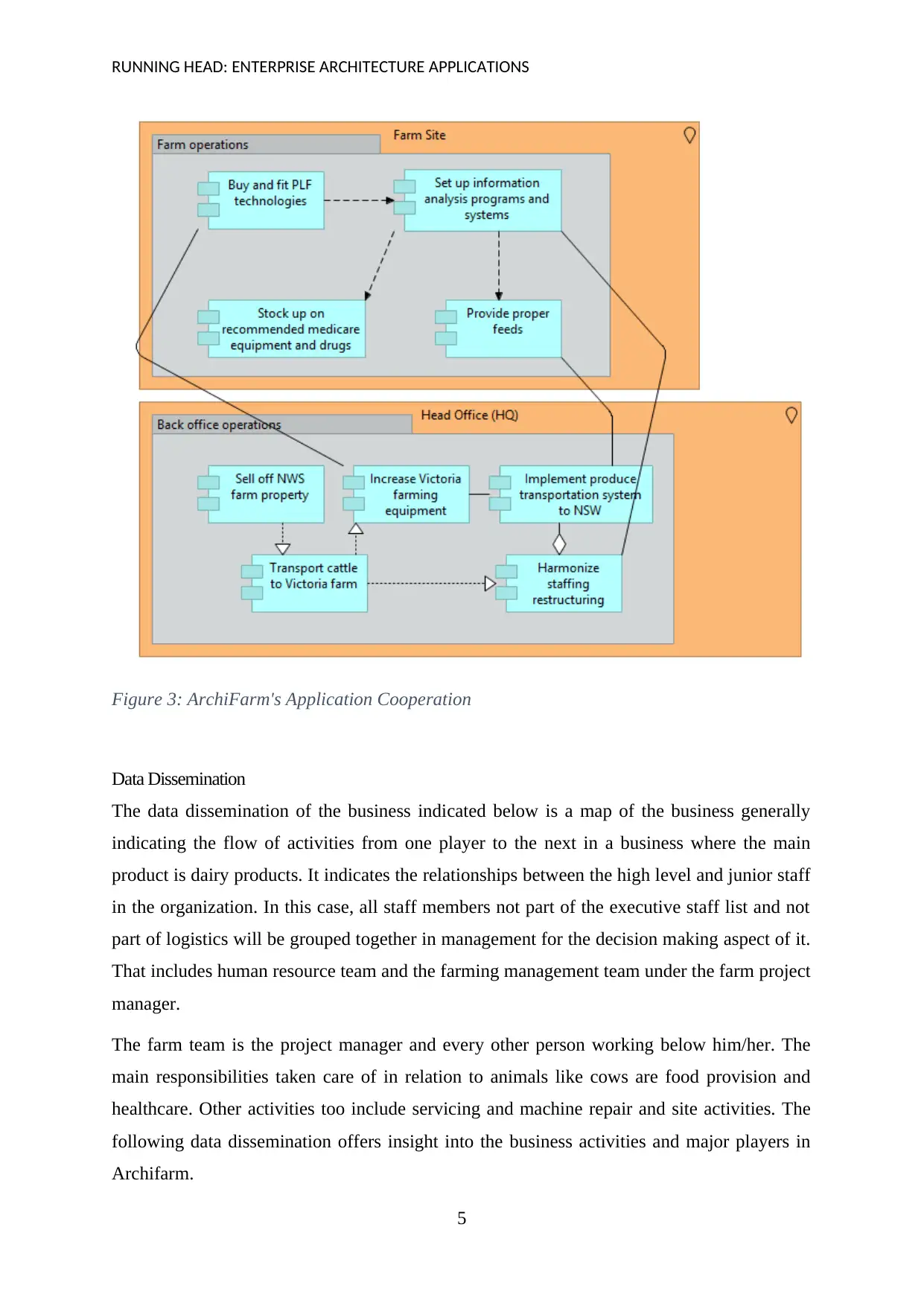
RUNNING HEAD: ENTERPRISE ARCHITECTURE APPLICATIONS
Figure 3: ArchiFarm's Application Cooperation
Data Dissemination
The data dissemination of the business indicated below is a map of the business generally
indicating the flow of activities from one player to the next in a business where the main
product is dairy products. It indicates the relationships between the high level and junior staff
in the organization. In this case, all staff members not part of the executive staff list and not
part of logistics will be grouped together in management for the decision making aspect of it.
That includes human resource team and the farming management team under the farm project
manager.
The farm team is the project manager and every other person working below him/her. The
main responsibilities taken care of in relation to animals like cows are food provision and
healthcare. Other activities too include servicing and machine repair and site activities. The
following data dissemination offers insight into the business activities and major players in
Archifarm.
5
Figure 3: ArchiFarm's Application Cooperation
Data Dissemination
The data dissemination of the business indicated below is a map of the business generally
indicating the flow of activities from one player to the next in a business where the main
product is dairy products. It indicates the relationships between the high level and junior staff
in the organization. In this case, all staff members not part of the executive staff list and not
part of logistics will be grouped together in management for the decision making aspect of it.
That includes human resource team and the farming management team under the farm project
manager.
The farm team is the project manager and every other person working below him/her. The
main responsibilities taken care of in relation to animals like cows are food provision and
healthcare. Other activities too include servicing and machine repair and site activities. The
following data dissemination offers insight into the business activities and major players in
Archifarm.
5
⊘ This is a preview!⊘
Do you want full access?
Subscribe today to unlock all pages.

Trusted by 1+ million students worldwide
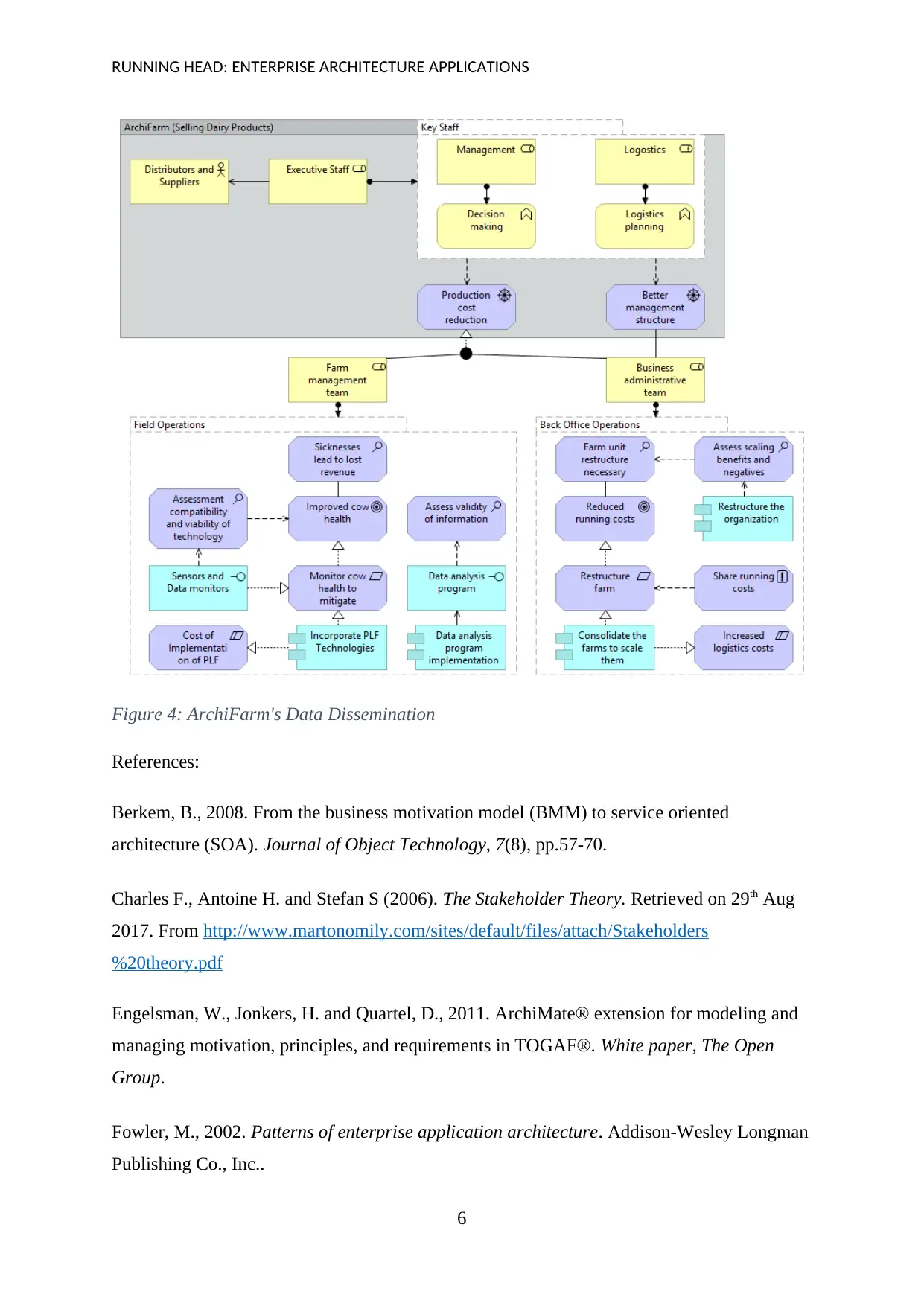
RUNNING HEAD: ENTERPRISE ARCHITECTURE APPLICATIONS
Figure 4: ArchiFarm's Data Dissemination
References:
Berkem, B., 2008. From the business motivation model (BMM) to service oriented
architecture (SOA). Journal of Object Technology, 7(8), pp.57-70.
Charles F., Antoine H. and Stefan S (2006). The Stakeholder Theory. Retrieved on 29th Aug
2017. From http://www.martonomily.com/sites/default/files/attach/Stakeholders
%20theory.pdf
Engelsman, W., Jonkers, H. and Quartel, D., 2011. ArchiMate® extension for modeling and
managing motivation, principles, and requirements in TOGAF®. White paper, The Open
Group.
Fowler, M., 2002. Patterns of enterprise application architecture. Addison-Wesley Longman
Publishing Co., Inc..
6
Figure 4: ArchiFarm's Data Dissemination
References:
Berkem, B., 2008. From the business motivation model (BMM) to service oriented
architecture (SOA). Journal of Object Technology, 7(8), pp.57-70.
Charles F., Antoine H. and Stefan S (2006). The Stakeholder Theory. Retrieved on 29th Aug
2017. From http://www.martonomily.com/sites/default/files/attach/Stakeholders
%20theory.pdf
Engelsman, W., Jonkers, H. and Quartel, D., 2011. ArchiMate® extension for modeling and
managing motivation, principles, and requirements in TOGAF®. White paper, The Open
Group.
Fowler, M., 2002. Patterns of enterprise application architecture. Addison-Wesley Longman
Publishing Co., Inc..
6
Paraphrase This Document
Need a fresh take? Get an instant paraphrase of this document with our AI Paraphraser
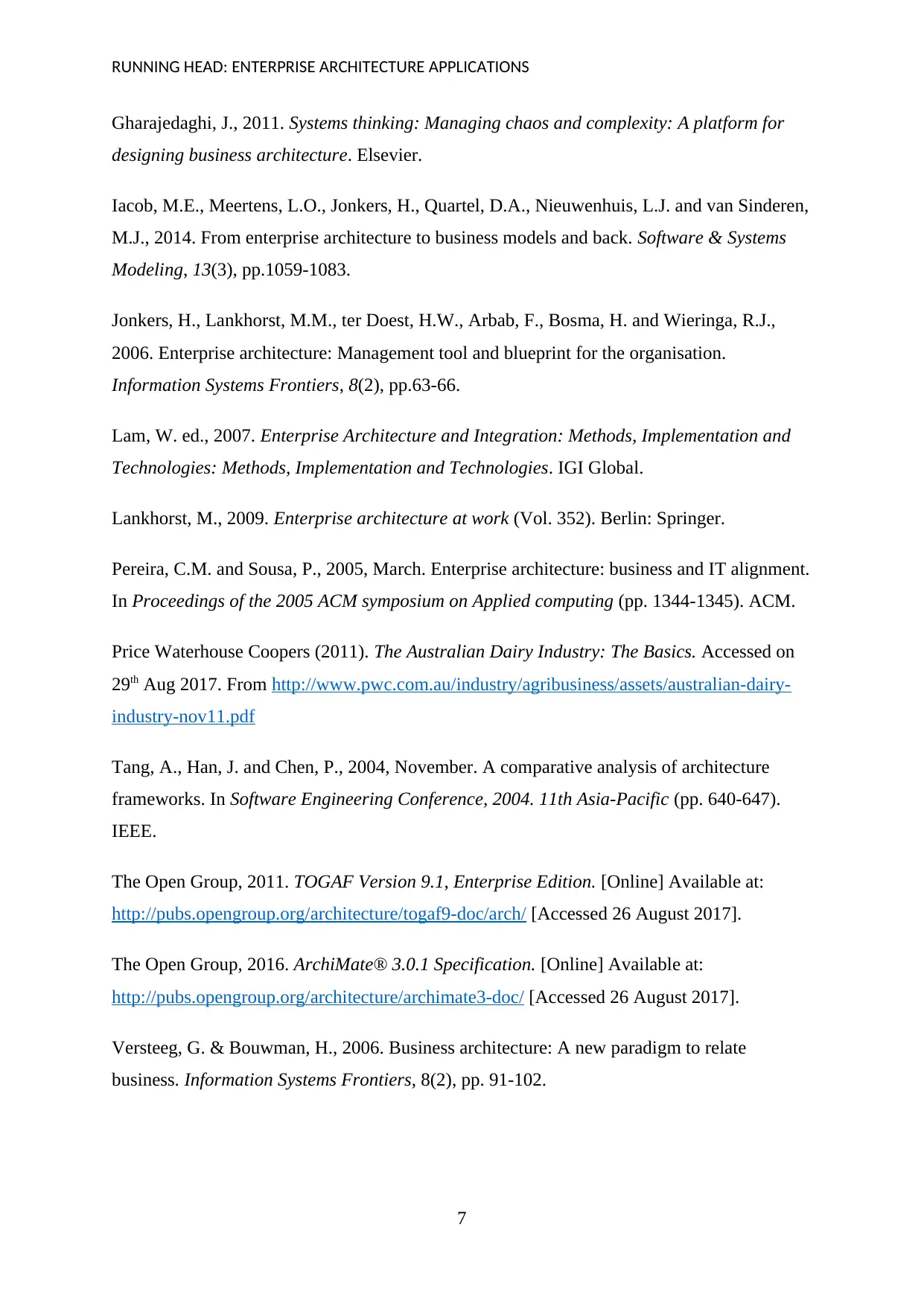
RUNNING HEAD: ENTERPRISE ARCHITECTURE APPLICATIONS
Gharajedaghi, J., 2011. Systems thinking: Managing chaos and complexity: A platform for
designing business architecture. Elsevier.
Iacob, M.E., Meertens, L.O., Jonkers, H., Quartel, D.A., Nieuwenhuis, L.J. and van Sinderen,
M.J., 2014. From enterprise architecture to business models and back. Software & Systems
Modeling, 13(3), pp.1059-1083.
Jonkers, H., Lankhorst, M.M., ter Doest, H.W., Arbab, F., Bosma, H. and Wieringa, R.J.,
2006. Enterprise architecture: Management tool and blueprint for the organisation.
Information Systems Frontiers, 8(2), pp.63-66.
Lam, W. ed., 2007. Enterprise Architecture and Integration: Methods, Implementation and
Technologies: Methods, Implementation and Technologies. IGI Global.
Lankhorst, M., 2009. Enterprise architecture at work (Vol. 352). Berlin: Springer.
Pereira, C.M. and Sousa, P., 2005, March. Enterprise architecture: business and IT alignment.
In Proceedings of the 2005 ACM symposium on Applied computing (pp. 1344-1345). ACM.
Price Waterhouse Coopers (2011). The Australian Dairy Industry: The Basics. Accessed on
29th Aug 2017. From http://www.pwc.com.au/industry/agribusiness/assets/australian-dairy-
industry-nov11.pdf
Tang, A., Han, J. and Chen, P., 2004, November. A comparative analysis of architecture
frameworks. In Software Engineering Conference, 2004. 11th Asia-Pacific (pp. 640-647).
IEEE.
The Open Group, 2011. TOGAF Version 9.1, Enterprise Edition. [Online] Available at:
http://pubs.opengroup.org/architecture/togaf9-doc/arch/ [Accessed 26 August 2017].
The Open Group, 2016. ArchiMate® 3.0.1 Specification. [Online] Available at:
http://pubs.opengroup.org/architecture/archimate3-doc/ [Accessed 26 August 2017].
Versteeg, G. & Bouwman, H., 2006. Business architecture: A new paradigm to relate
business. Information Systems Frontiers, 8(2), pp. 91-102.
7
Gharajedaghi, J., 2011. Systems thinking: Managing chaos and complexity: A platform for
designing business architecture. Elsevier.
Iacob, M.E., Meertens, L.O., Jonkers, H., Quartel, D.A., Nieuwenhuis, L.J. and van Sinderen,
M.J., 2014. From enterprise architecture to business models and back. Software & Systems
Modeling, 13(3), pp.1059-1083.
Jonkers, H., Lankhorst, M.M., ter Doest, H.W., Arbab, F., Bosma, H. and Wieringa, R.J.,
2006. Enterprise architecture: Management tool and blueprint for the organisation.
Information Systems Frontiers, 8(2), pp.63-66.
Lam, W. ed., 2007. Enterprise Architecture and Integration: Methods, Implementation and
Technologies: Methods, Implementation and Technologies. IGI Global.
Lankhorst, M., 2009. Enterprise architecture at work (Vol. 352). Berlin: Springer.
Pereira, C.M. and Sousa, P., 2005, March. Enterprise architecture: business and IT alignment.
In Proceedings of the 2005 ACM symposium on Applied computing (pp. 1344-1345). ACM.
Price Waterhouse Coopers (2011). The Australian Dairy Industry: The Basics. Accessed on
29th Aug 2017. From http://www.pwc.com.au/industry/agribusiness/assets/australian-dairy-
industry-nov11.pdf
Tang, A., Han, J. and Chen, P., 2004, November. A comparative analysis of architecture
frameworks. In Software Engineering Conference, 2004. 11th Asia-Pacific (pp. 640-647).
IEEE.
The Open Group, 2011. TOGAF Version 9.1, Enterprise Edition. [Online] Available at:
http://pubs.opengroup.org/architecture/togaf9-doc/arch/ [Accessed 26 August 2017].
The Open Group, 2016. ArchiMate® 3.0.1 Specification. [Online] Available at:
http://pubs.opengroup.org/architecture/archimate3-doc/ [Accessed 26 August 2017].
Versteeg, G. & Bouwman, H., 2006. Business architecture: A new paradigm to relate
business. Information Systems Frontiers, 8(2), pp. 91-102.
7
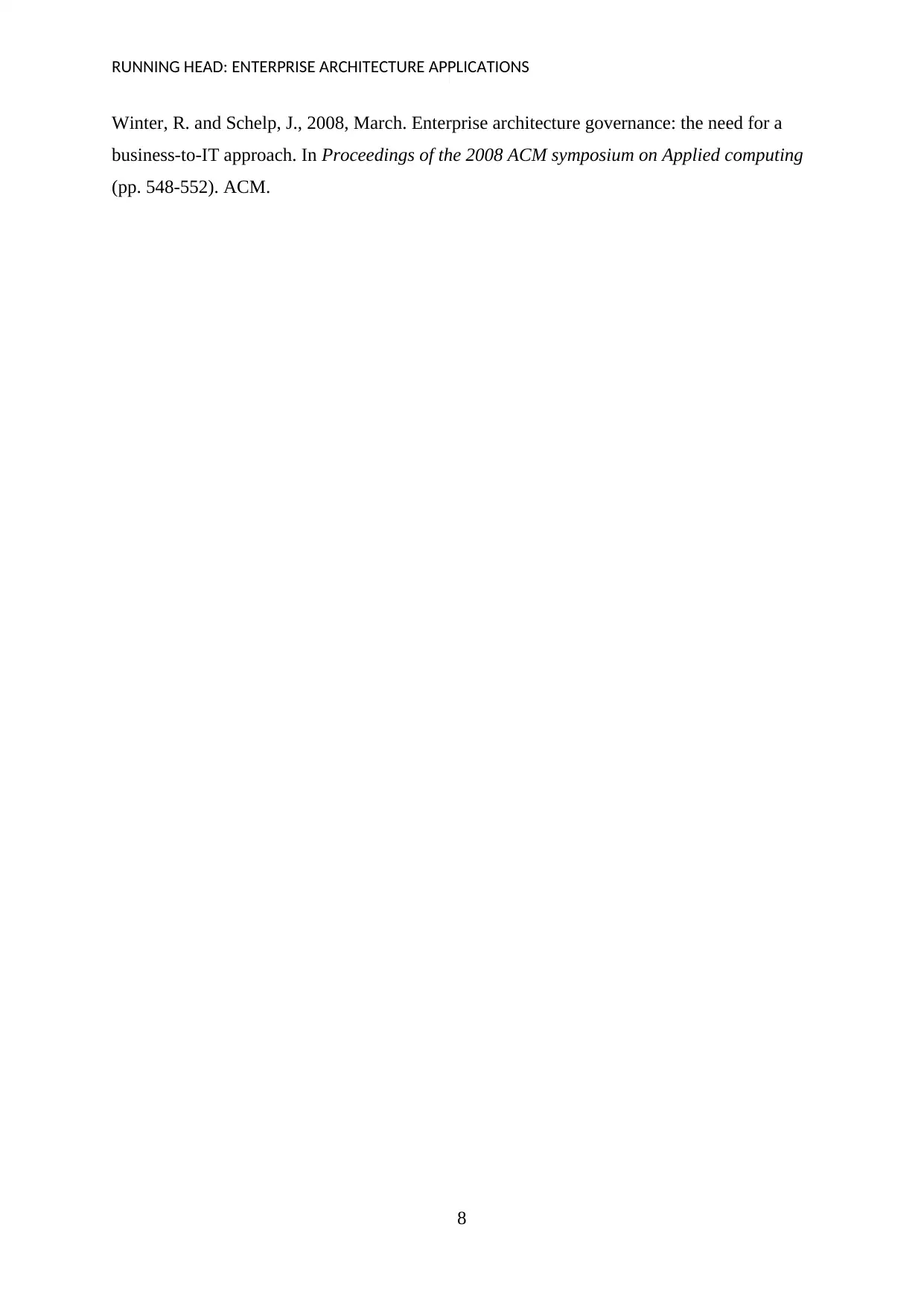
RUNNING HEAD: ENTERPRISE ARCHITECTURE APPLICATIONS
Winter, R. and Schelp, J., 2008, March. Enterprise architecture governance: the need for a
business-to-IT approach. In Proceedings of the 2008 ACM symposium on Applied computing
(pp. 548-552). ACM.
8
Winter, R. and Schelp, J., 2008, March. Enterprise architecture governance: the need for a
business-to-IT approach. In Proceedings of the 2008 ACM symposium on Applied computing
(pp. 548-552). ACM.
8
⊘ This is a preview!⊘
Do you want full access?
Subscribe today to unlock all pages.

Trusted by 1+ million students worldwide
1 out of 9
Related Documents
Your All-in-One AI-Powered Toolkit for Academic Success.
+13062052269
info@desklib.com
Available 24*7 on WhatsApp / Email
![[object Object]](/_next/static/media/star-bottom.7253800d.svg)
Unlock your academic potential
Copyright © 2020–2025 A2Z Services. All Rights Reserved. Developed and managed by ZUCOL.





